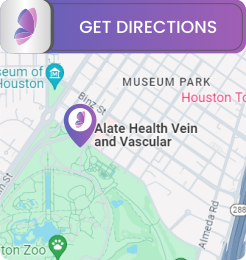Peripheral Arterial Disease (PAD) Treatment Specialist in Houston TX
Peripheral arterial disease (PAD) is a vascular condition that causes artery narrowing or blockage, generally due to coronary artery disease. Leg pain, cramps, and fatigue are among the most common symptoms. Severe cases can cause sores or ulcers, while rarer cases can result in gangrene and amputation. If you’re suffering leg discomfort or unusual weariness, particularly during activity, Dr. Andrew Doe, MD, at Alate Health Interventional Radiology Clinic have PAD treatment options to enhance blood flow and manage your symptoms. For more information, contact us today or book an appointment online now. We are conveniently located at 1213 Hermann Dr Suite 255, Houston, TX 77004.


Table of Contents:
What is Peripheral Arterial Disease?
What are the symptoms of Peripheral Arterial Disease?
What are the stages of PAD?
How long can a PAD go untreated?
Peripheral artery disease is a serious condition that can drastically affect your wellness and mobility. In this condition, the extremities don’t receive enough blood flow due to the narrowing of the arteries. Most commonly, PAD is a sign of the buildup of fatty deposits within the arteries, referred to as atherosclerosis. This condition is more common among older adults and patients with diabetes. In addition, high blood pressure and elevated cholesterol levels are also linked with the development of PAD. To prevent complications such as heart attack, stroke, and critical limb ischemia as a result of PAD, it’s important to see a doctor promptly for early detection and effective treatment.
Many people who have peripheral artery disease do not experience any symptoms at all or only notice mild and intermittent symptoms.PAD leads to claudication, which results in mild to severe muscle pain and cramping in the extremities.
Furthermore, other symptoms associated with this condition include:
– Leg numbness or weakness.
– Muscle cramps in the thighs, hips, or calves.
– Pain in the arms when performing manual tasks.
– Chronic sores on the feet or legs.
– Changes in skin color on the legs.
– Cool skin on the feet.
– Shiny skin on the legs.
– Frequent skin or soft tissue infections.
– Slow-growing toenails.
– An aching or burning sensation in the feet or toes at rest.
– Hair loss on the legs.
– Erectile dysfunction.
In severe cases, peripheral artery disease can result in sleep disruptions due to discomfort. If you notice leg numbness, muscle cramping, or other symptoms of PAD, you should consult a healthcare provider to receive an accurate diagnosis and support managing your discomfort.
The four stages of PAD are:
Asymptomatic PAD: In the earliest stage of PAD, many individuals do not exhibit any noticeable symptoms. Despite the lack of symptoms, there is underlying atherosclerosis causing some degree of arterial narrowing.
Claudication: When PAD causes claudication, pain, and cramping are the most common symptoms. The pain typically occurs in the calf, thigh, or buttock, depending on the location of the arterial blockage.
Ischemic rest pain: As PAD progresses, blood flow becomes insufficient even at rest, leading to ischemic rest pain. This severe pain occurs in the feet or toes and is often worse at night when lying down.
Ulcers or gangrene: The most advanced stage of PAD is characterized by the development of non-healing ulcers or tissue death due to severely restricted blood flow.
It’s essential to address the symptoms of peripheral artery disease before the condition progresses into more advanced stages. By working with a PAD treatment specialist, you can successfully manage the condition and prevent severe complications, such as tissue death that requires amputation and a heightened risk of heart attack or stroke.
Peripheral artery disease is a chronic condition that requires prompt management. Putting off seeing your doctor about your symptoms or delaying treatment can lead to serious consequences. While there are various treatment options for those diagnosed with PAD, the longer you wait to seek treatment, the more limited your options will be. In addition, treatment for PAD will be more expensive and invasive the more advanced the condition becomes.
While PAD cannot be cured, this condition can be successfully managed through medications, lifestyle changes, or stent placement. Without proper treatment, your symptoms will continue to worsen and may significantly interfere with your quality of life. To prevent a higher risk of heart failure, stroke, heart attack, or gangrene, you should see a PAD treatment specialist as promptly as possible for an accurate diagnosis and personalized management.
To receive comprehensive support in managing peripheral artery disease, schedule an appointment with the specialist at Alate Health Interventional Radiology Clinic. For more information, contact us today or book an appointment online. We are conveniently located at 1213 Hermann Dr Suite 255, Houston, TX 77004. We serve patients from Houston TX, Bellaire TX, Jacinto City TX, Spring Valley Village TX, Stafford TX, Bunker Hill Village TX, and surrounding cities.

Additional Services You May Need
▸ Adenomyosis
▸ Enlarged Prostate
▸ Leg Ulcers
▸ Joint Pain
▸ Varicose Veins
▸ Uterine Fibroids
▸ Pelvic Congestion
▸ Vascular Malformations
▸ Dialysis/Renal Failure
▸ Port and PICC Placements
▸ Peripheral Arterial Disease
▸ Primary and Metastatic Liver Cancers
▸ Hemorrhoid Artery Embolization (HAE)







